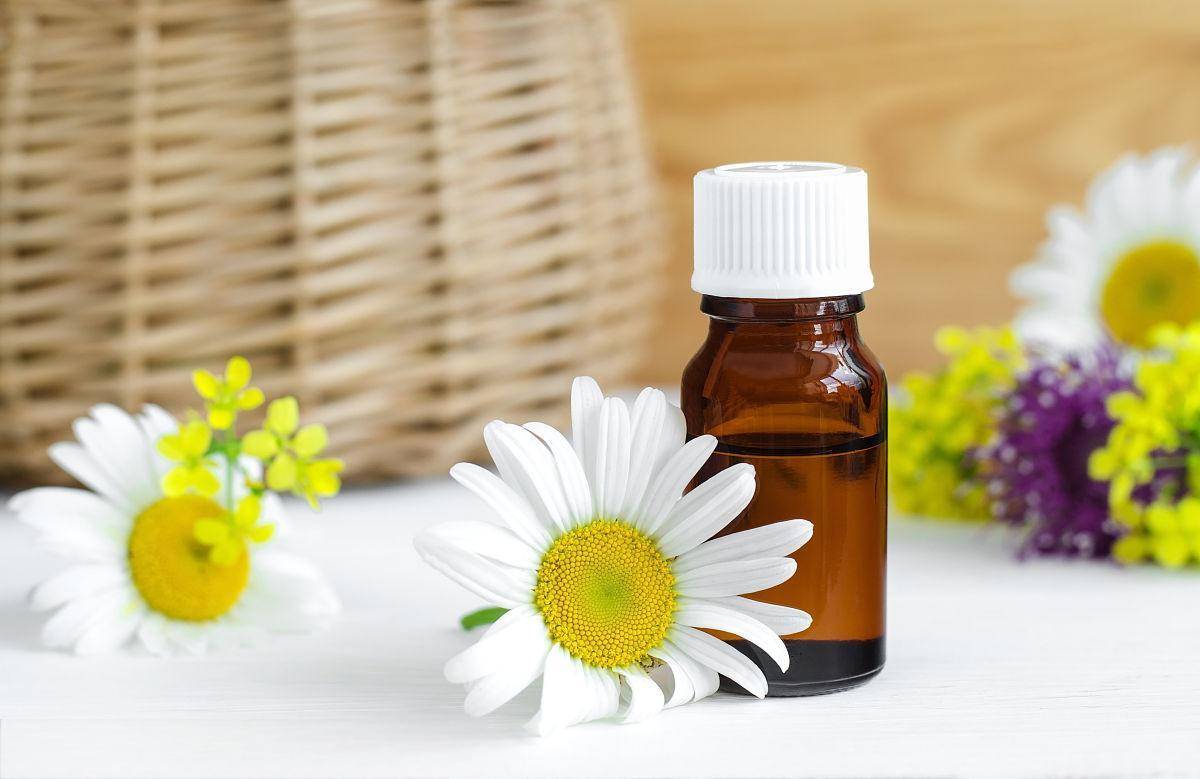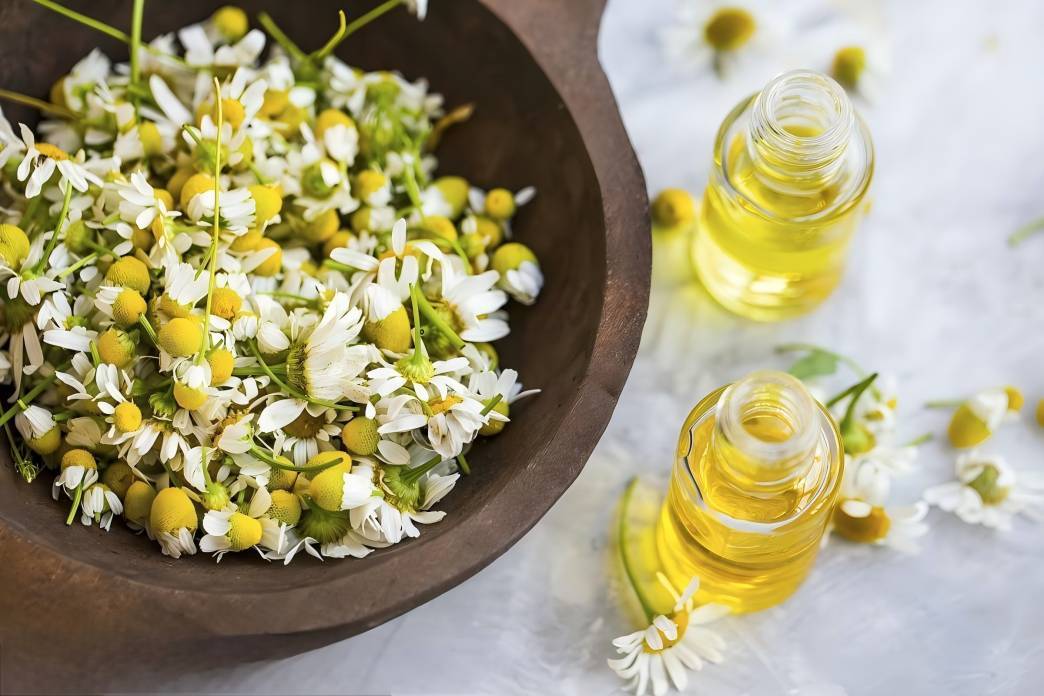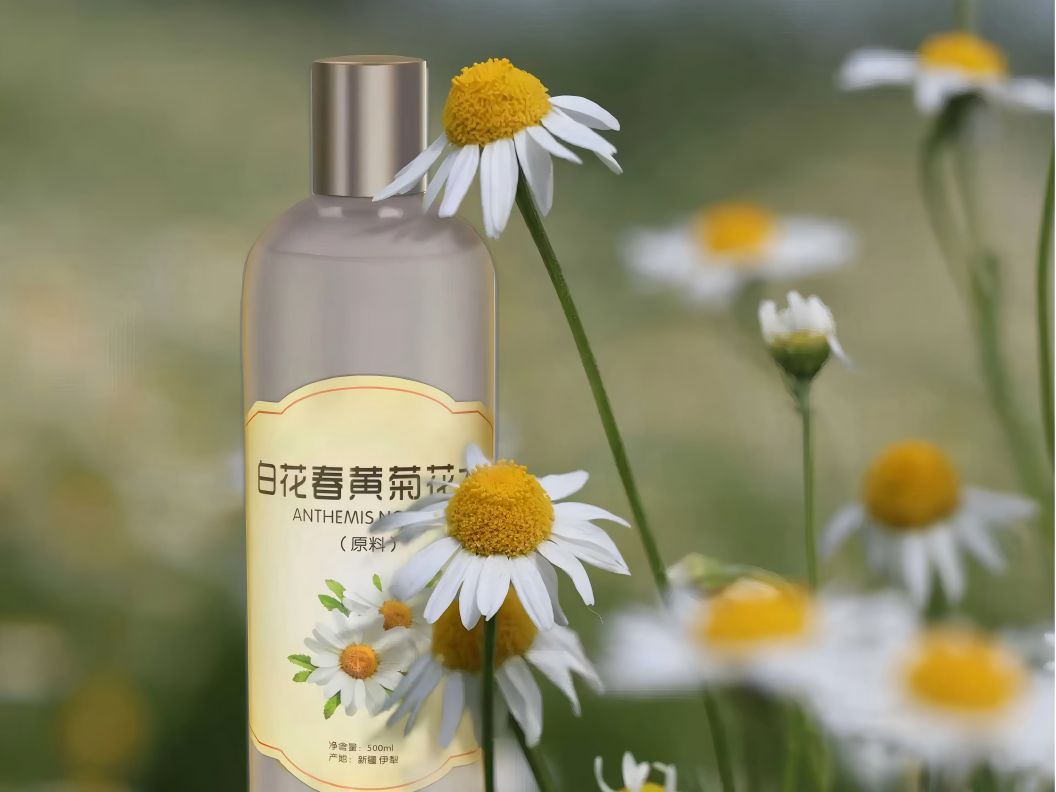What Are the Benefits of Chamomilla Recutita Flower Extract?
Chamomile (Matricaria chamomilla L.) is an annual herb in the Asteraceae family, native to northern and western Xinjiang in China, and also distributed in Europe, northern and western Asia[1]. Chamomile is a commonly used medicinal herb in Uyghur traditional medicine. According to the Uyghur Pharmacopoeia, Uyghur medicine chamomile is also known as “Babunai”. It has the functions of antispasmodic, anti-inflammatory, antipyretic, promoting ulcer healing and bactericidal, etc. Its main functions are clearing away heat and resolving exopathogens, calming the mind and tranquilizing the nerves, dispelling wind and strengthening the stomach, nourishing the brain and strengthening the kidneys. It is used for colds and fever, insomnia and agitation, lack of energy, wind-cold stomach pain, cramped hands and feet, and sore lower back and knees[2].
The Ministry of Health of the People's Republic of China Drug Standards (Uyghur Medicine Volume) has included this herb and three of its compound preparations: Compound Muminqi Granules, Zukamusi Granules, and Qiangli Madexili Ayat Honeycomb[3]. Chamomile also has a long history of use in Europe, dating back to ancient Greece and Rome[4], and is currently included in the pharmacopoeia of 26 countries[5]. Traditionally, chamomile is used internally to treat gastrointestinal spasms and inflammatory diseases[6]. Modern pharmacological studies have shown that chamomile also has antibacterial, anti-inflammatory and analgesic, antioxidant, hypoglycemic, hypolipidemic, antihypertensive, antitumor, antiparasitic effects and many pharmacological effects on the gastrointestinal system and nervous system. This article intends to provide a review of the chemical composition and pharmacological effects, and to predict the analysis of quality markers (Q-markers) of chamomile, with a view to providing a reference for the quality control and rational use of medicinal materials.

1 Chemical composition
With the improvement of chromatographic techniques and the optimization of extraction and separation conditions, flavonoids, phenolic acids, coumarins, essential oils and many other types of ingredients have been isolated from Chamomilla Recutita Flower Extract. These chemical ingredients are closely related to the pharmacological effects of chamomile.
1. 1 Flavonoids
Flavonoids are the main active ingredients in chamomile. The majority of the flavonoids in Chamomilla Recutita Flower Extract are flavones, flavonols and their glycosides, followed by a small amount of dihydroflavonoids and flavanols. Apigenin is the most abundant flavonoid in chamomile flowers, present in small amounts in its free form and in other forms such as mono- and disaccharide glycosides and their acetylated derivatives [7]. The main flavonoids are shown in Figure 1 and Table 1.
1. 2 Phenolic acid compounds
Phenolic acid compounds are one of the main bioactive substances in chamomile. Chamomilla recutita flower extract contains various caffeoylquinic acids (53–58, 62–63), quinic acid (59), 2-β-D-glucopyranosyl-4-methoxycinnamic acid isomers (60 ~ 61), benzoic acid derivatives (64 ~ 70) and hydroxycinnamic acid derivatives (71 ~ 75). The phenolic acid compounds are shown in Table 2 and Figure 2.
1. 3 Coumarins
Eleven coumarin compounds have been reported in Chamomilla Recutita Flower Extract, including hydroxyl and methoxy-substituted coumarins (77-82, 84, 87) and coumarin glycosides (83, 85-86), all of which are simple coumarins, as shown in Table 3 and Figure 3.
1. 4 Volatile oil
The volatile oil is a complex mixture of mainly aromatic, terpene and aliphatic components. The main components of chamomile essential oil are sesquiterpenes, monoterpenes, and a small amount of aliphatic compounds. α-Bisabolol and its oxides and matricaria are the main components of chamomile essential oil [25]. A study used solvent-assisted distillation combined with liquid-liquid chromatography [26] to isolate chamomile essential oil and identify nine sesquiterpene components. The essential oil composition and content in chamomile flowers and stems and leaves are different [27]. α-Bisabolol oxides A and B, α-bisabolene oxides A and B, and matricaria are higher in flowers, while cineol, (E)-β-elemene and cis-en-yn-Dicyc- loether are higher in stems and leaves. See Table 4.
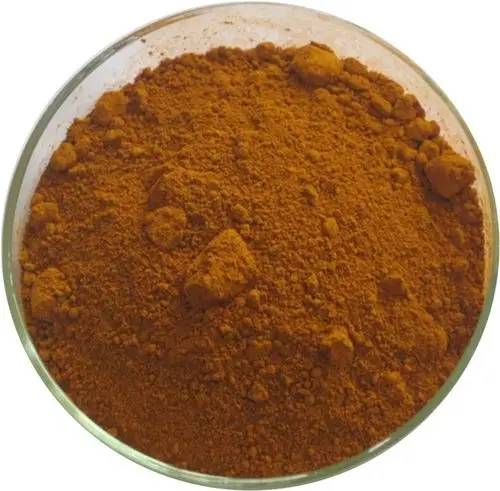
1. 5 Other ingredients
Studies have shown that Chamomilla Recutita Flower Extract contains oleanolic acid, stigmasterol, β-sitosterol, β-sitosterol-glucoside [29], geniposidic acid, resveratrol and coniferyl aldehyde [15]. In addition, studies have isolated three components from chamomile: p-hydroxyacetophenone, palmatoside A, and matriisobenzofuran [24]. Zhao et al. [10] isolated 5-pentadecylresorcinol, a compound that was first isolated from chamomile and Tanacetum plants.
2 Pharmacological effects
With the deepening of modern pharmacological research, Chamomilla Recutita Flower Extract has been found to have a wide range of pharmacological effects, such as antibacterial and analgesic, antioxidant, hypoglycemic and hypolipidemic, antihypertensive, antitumor, antiparasitic, and cardiovascular and nervous system protective effects, in addition to its traditional use in inflammatory diseases. The pharmacological effects of chamomile have been studied mainly on chamomile water, alcohol extracts, essential oils and the isolated monomer compounds from chamomile, and the research direction has also shifted from pharmacodynamic observation and testing to the exploration of pharmacological mechanisms.
2. 1 Gastrointestinal system effects
Chamomile can be used for a variety of gastrointestinal diseases such as flatulence, gastric ulcers and gastrointestinal irritation [25]. The 200 mg ·kg- 1 ·d - 1 chamomile aqueous alcohol extract group had the strongest protective effect against acute gastric mucosal damage caused by ethanol in rats, and the gastric ulcer index was lowest [30]. 25, 50 and 100 mg ·kg- 1 ·d - 1 Chamomile decoction has a protective effect on ethanol-induced gastric mucosal damage and oxidative stress, and can significantly reduce the gastric ulcer index (46. 77%, 63. 30% and 90. 95%), due to its antioxidant properties and its role in strengthening the gastric mucosal defense factors [31]. Studies have found [6] that chamomile can inhibit the activity and secretion of neutrophil elastase and matrix metalloproteinase-9 (MMP-9) in AGS human gastric adenocarcinoma cells. The reduction in MMP-9 expression is related to the inhibition of NF-κB-driven transcription. Chamomile powdered water extract has an antidiarrheal effect and can prevent acute diarrhea in Wistar rats caused by castor oil[32]. It exerts anti-intestinal fluid secretion and antispasmodic activity through K+ channel activation and weak Ca2+ antagonism[33].
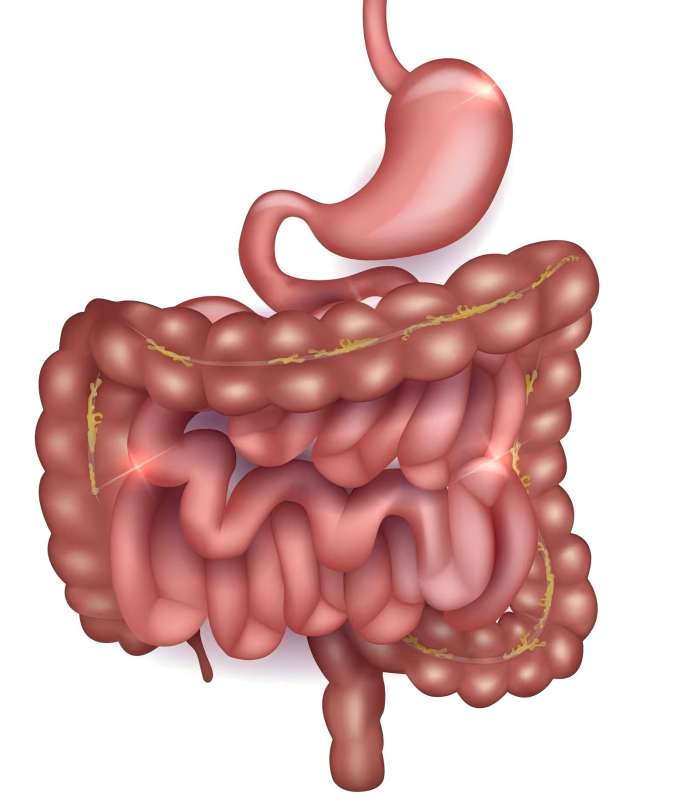
2. 2 Antioxidant and hepatoprotective effects
The active antioxidant ingredients of Chamomilla Recutita Flower Extract include total phenols [34], total flavonoids [35] and sesquiterpenes [36]. Its effects are manifested in scavenging active oxygen metabolites, inhibiting lipid peroxidation and improving oxidative stress levels. After 8 weeks of continuous administration of 200 mg·kg-1·d-1 Chamomilla Recutita Flower Extract to diabetic rats, the level of malondialdehyde (MDA) in the liver decreased, and superoxide dismutase (SOD) activity increased to the normal level of the healthy control group [37]. 500 mg ·kg- 1 ·d - 1 chamomile flower extract for 4 weeks significantly increased the activities of SOD, catalase (CAT) and glutathione peroxidase (GSH-Px) in the liver of streptozotocin-induced diabetic rats, and inhibited lipid peroxidation levels [38].
Chamomile water extract inhibits the production of reactive oxygen species in human neutrophils [39], and has a protective effect on red blood cell oxidative stress. At the same time, 25, 50, and 100 mg·kg-1·d-1 chamomile water extract doses reversibly reduced ethanol-induced decreases in antioxidant enzyme SOD, CAT, and GSH-Px levels in rats in a dose-dependent manner. The antioxidant effect of the high-concentration chamomile extract was comparable to that of the antioxidant ascorbic acid. In a model of oxidative damage to the liver of male Wistar rats caused by paraquat [40], oral administration of 50 mg · kg-1 · d-1 chamomile extract for 7 days increased the level of total sulfhydryl molecules in rat liver tissue and and lowered alanine aminotransferase (ALT) and aspartate aminotransferase (AST) levels, preventing liver damage by scavenging free radicals and stabilizing the oxidation state.
2. 3 Anti-inflammatory and analgesic effects
Chamomile is effective in reducing oral inflammation, accelerating wound healing and providing analgesia [41]. It has clinical efficacy for oral mucositis [42], lichen planus [43] and burning mouth syndrome [44]. Chamomile inhibits the expression of tumor necrosis factor-α (TNF-α) and interleukin-1β (IL-1β) in a rat alveolitis model caused by nylon thread ligation, reduces leukocyte infiltration in periodontal tissues, and reduces the activity of myeloperoxidase to normal levels. TNF-α) and interleukin-1β (IL-1β) expression, reduce leukocyte infiltration in periodontal tissues, and lower myeloperoxidase activity to normal levels. Immunohistochemical results show that chamomile prevents rat alveolar bone inflammation by reducing the RANKL/OPG ratio [45]. Chamomile ointment treatment reduces epithelial cell apoptosis and TNF-α expression in rats and promotes the healing of traumatic oral ulcers in diabetic rats [46]. A compound preparation containing chamomile can reduce the expression of IL-1β and joint inflammation in a rat model of rheumatoid arthritis induced by injection of complete Freund's adjuvant [47].
The main chemical components of Chamomilla Recutita Flower Extract, (–)-α-bisabolol[48], apigenin and quercetin[49], inhibit the expression of IL-1β, interleukin-6 (IL-6), TNF-α, inducible nitric oxide synthase (iNOS) and cyclooxygenase-2 (COX-2) to reduce inflammation. Matricaria recutita significantly downregulates the expression of IL-1β-induced MMP-3, MMP-9 and NF-κB in chondrocytes, by regulating the MMPs and NF-κB pathways to reverse the inflammatory progression of osteoarthritis [50]. Essential oil components downregulate IL-6 mRNA expression in LPS-induced human keratinocytes and regulate the two signal pathways of p38 MAPK and mTOR to reduce inflammatory damage [51].
Chamomile essential oil extract can dose-dependently inhibit the hyperalgesia of inflammatory models in rats [52], reduce the amount of analgesic drugs used by patients with knee osteoarthritis [53], relieve mild to moderate mastalgia in patients with mastitis [54] and the symptoms of pain and nausea in patients with migraine [55]. The mechanism of action of chamomile's analgesic effect is related to its anti-inflammatory effect. (–)-alpha-bisabolol exerts an analgesic effect in inflammatory models of visceral and somatic pain and reduces pain hypersensitivity in inflammation [56].
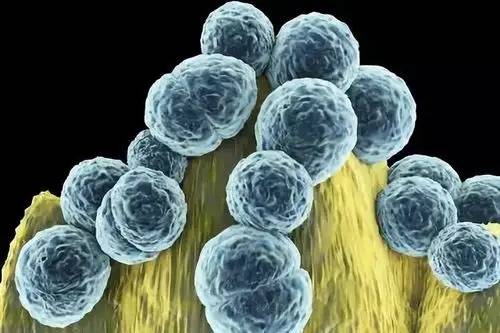
2. 4 Antibacterial effect
Chamomile essential oil has an antibacterial effect and has bacteriostatic activity against Listeria monocytogenes, Escherichia coli[28] , Bacillus cereus, Aspergillus flavus[22] and Aspergillus niger[4]. The main component, α-bisabolol, can inhibit Staphylococcus aureus, Escherichia coli and Pseudomonas aeruginosa, with the best inhibitory effect on Staphylococcus aureus, with a minimum inhibitory concentration of 161.27 μg·mL-1[57] , and has bacteriostatic activity against Clostridium perfringens, which is associated with bad breath [58]. α-Bisabolol has an inhibitory effect on fungi such as Candida albicans, C. crucis, and C. tropicalis [59], and can also inhibit the dermatophyte pathogens of the genus Trichophyton, such as T. rubrum and T. interdigitale [60], so it has potential for use in the treatment of dermatophyte infections.
2. 5 Effects on the cardiovascular system
2. 5. 1 Hypoglycemic effect
Chamomile water and alcohol extracts, when administered continuously for 28 days, can reduce fasting blood glucose and improve glucose tolerance in mice with diabetes induced by alloxan [61-63]. In a clinical study [64], the serum insulin level, insulin, glycated hemoglobin, and insulin resistance index of type 2 diabetes patients taking chamomile tea were reduced by 11. 09%, 32. 59%, 5. 01% and 39. 76% respectively. Alpha-amylase and alpha-glucosidase catalyze the hydrolysis of the carbohydrate α-(1, 4) glycosidic bond, which can lead to elevated blood glucose levels [65]. Apigenin isolated from chamomile has inhibitory activity against both enzymes and has stronger inhibitory effect on α-glucosidase [66].
Apigenin and apigenin-7-O-glucoside, (Z) and (E)-2-β-D-glucopyranosyloxy-4-methoxycinnamic acid [19] can all regulate carbohydrate digestion and absorption in vitro by inhibiting the activity of α-amylase and maltase. Quercetin, luteolin and 6,7-dihydroxycoumarin inhibit the activity of α-glucosidase and glycogen phosphorylase, and inhibit hepatic glycogenolysis [67]. Chamomile flower ethanol extract can significantly increase insulin levels and insulin sensitivity, and reduce the level of glycoprotein phospholipase D in diabetic rats [68]. The uptake of glucose and fructose at low concentrations depends on the sodium-glucose co-transporters1 (SGLT1) and glucose transporter 5 (GLUT5) transporters, respectively, while uptake at high concentrations mainly depends on GLUT2 transport [69].
Chamomile inhibits the absorption of fructose and glucose by inhibiting GLUT2 and GLUT5 at different concentrations [70]. At low concentrations, it inhibits SGLT1 and reduces the intestinal absorption of glucose in vitro[20]. At high concentrations, apigenin and apigenin 7-O-glucoside act as selective inhibitors of GLUT2, directly interacting with the GLUT2 transporter[19]. Chamomile can also regulate glycolipid metabolism by activating peroxisome proliferators-activated receptors-γ (PPARγ) [71].
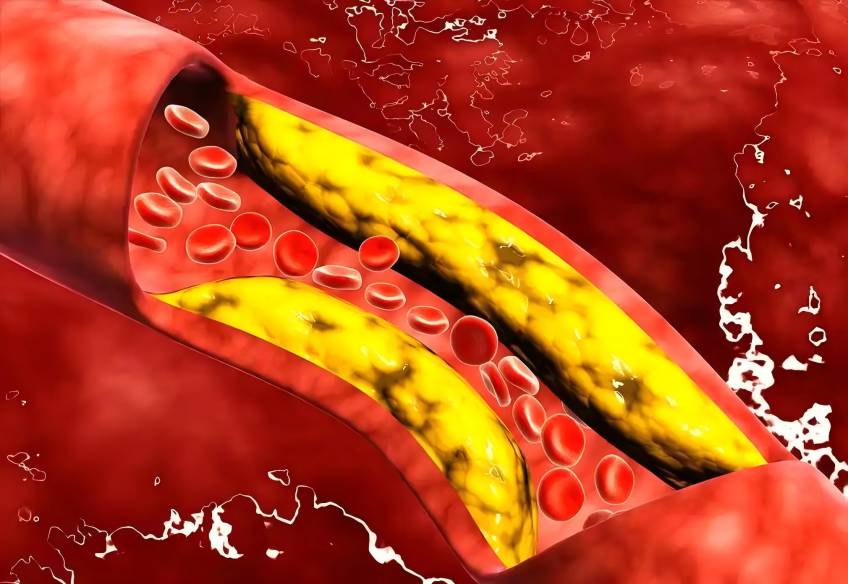
2. 5. 2 Hypolipidemic effect
In a clinical trial[72], after taking chamomile tea for 4 weeks, the total cholesterol (TC) and low-density lipoprotein cholesterol (LDL-C) levels of diabetic patients decreased significantly. 300 mg·kg-1·d-1 Chamomilla Recutita Flower Extract can reduce TC, triglyceride (TG), LDL-C and very low-density lipoprotein cholesterol and increase high-density lipoprotein cholesterol levels in diabetic rats[73], and significantly reduce ALT, AST and alkaline phosphatase levels[74]. Chamomile total flavonoids TG), LDL-C and very low-density lipoprotein cholesterol, and elevated high-density lipoprotein cholesterol levels [73], significantly reducing ALT, AST and alkaline phosphatase levels [74]. Chamomile total flavonoids have an inhibitory effect on pancreatic lipase [75] and can effectively reduce intestinal absorption of TG [76]. In ApoE-/- model mice, total flavonoids inhibit TG synthesis by down-regulating the expression of proteins in the ACC/FAS/DGAT2 signaling pathway, improve blood lipid levels[77] , increase the expression levels of PPARα, CPT1A, and ACOX1 proteins[78] , and up-regulate PPARα protein expression to promote fatty acid oxidation, thereby reducing lipid deposition in liver tissue.
2. 5. 3 Hypotensive effect
Chamomile water and butanol extract have an inhibitory effect on the activity of angiotensin-I converting enzyme (ACE) in human plasma in vitro[79] , with IC50 values of 1. 292 and 0. 353 mg ·mL - 1 , the mechanism of lowering blood pressure may be non-competitive ACE inhibition. Chamomilla Recutita Flower Extract, when administered by gavage for 8 weeks, can reduce the levels of AngⅡ, Ang1-7 and Cys-C in rats with hypertension induced by l-nitroarginine, improve oxidative stress, and alleviate heart and kidney damage caused by hypertension [80].
2. 6 Anti-tumor effect
Chamomile has a selective cytotoxic effect on human malignant cells. Chamomile has a significant inhibitory effect on cervical cancer HeLa, breast cancer MDA-MB-361 and colon cancer LS174 cells, and the inhibitory activity on human chronic myeloid leukemia K562 cells is the strongest [81]. A study compared the anti-tumor activity of chamomile water extracts, decoctions and methanol extracts [17]. The results showed that chamomile decoctions had no anti-tumor activity, while the methanol extracts and water extracts, which contained high levels of organic acids and flavonoids, inhibited the activity of colon cancer cells HCT-15 and HeLa. Chamomile total flavonoids and phenolic acids have anti-proliferative and pro-apoptotic effects on the A375 human melanoma cell line [82].
Chamomile can also inhibit the formation of tumor blood vessels in HepG2 human liver cancer cells by dose-dependently down-regulating the expression level of VEGF2 protein in the vascular endothelial growth factor (vascular endothelial growth factor, VEGF2 protein expression levels in the vascular endothelial growth factor (VEGF) signaling pathway to inhibit the formation of tumor blood vessels in HepG2 human liver cancer cells [83]. In a 1,2-dimethylhydrazine-induced mouse colorectal cancer model, chamomile water extract significantly down-regulated the expression levels of Wnt5a, β-catenin, Tcf4, Lef1, c-Myc and Cyclin D1 by inhibiting the Wnt pathway [84].
2. 7 Effects on the nervous system
2. 7. 1 Neuroprotective effects
Chamomile ethanol extract has a protective effect on formaldehyde-induced damage to hippocampal neurons in rats [85], which is achieved by reducing the level of MDA in the hippocampus and increasing total antioxidant capacity. Chamomile treatment combined with endurance training together reduced the necrosis of hippocampal CA3 region nerve cells in diabetic rats, significantly improving cognitive function [86]. It prevented cholinergic dysfunction by inhibiting acetylcholinesterase activity, dose-dependently increased hippocampal brain-derived neurotrophic factor mRNA in rats, reduced IL-1β mRNA levels, improved memory deficits, and anti-neuroinflammation [87].
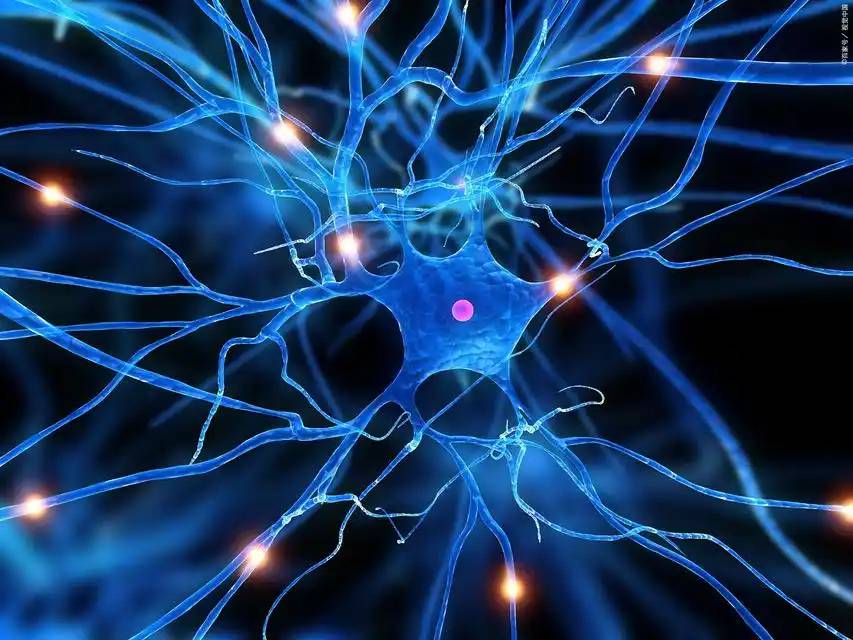
2. 7. 2 Anti-anxiety and hypnotic effects
In patients with moderate to severe generalized anxiety disorder, anxiety symptoms were reduced after short-term [88] and long-term [89] use of chamomile. In a study [90], 179 patients with generalized anxiety disorder were divided into two groups based on whether they also had depression. After receiving Chamomilla Recutita Flower Extract 1,500 mg·d-1 for 8 weeks, both groups showed an anti-anxiety effect. Among the subjects with comorbid depression, the score on the core symptoms of the depression rating scale showed a more pronounced downward trend, suggesting that it may have antidepressant effects. Chang et al. [91] used three scales to evaluate the effects of chamomile on sleep quality, fatigue and depression in postpartum women. Chamomile tea intervention for 2 weeks significantly improved sleep and depressive symptoms in postpartum women. Chamomile sedative and hypnotic effects are due to the binding of apigenin and flavonoids to benzodiazepine receptors [92].
2. 8 Anti-parasitic effects
The main component of chamomile essential oil, α-bisabolol, has anti-parasitic effects and insecticidal activity against the blood-sucking nematode Angiostrongylus cantonensis[93], the amoeba Acanthamoeba[94], the trophozoite stage of Acanthamoeba[95] and the protozoan Leishmania[96]. α-Bisabolol induces apoptosis[97] , causing externalization of phosphatidylserine and damage to the cell membrane, and reducing mitochondrial membrane potential and total ATP levels.
2. 9 Other effects
Chamomile can reduce the adverse effects of formaldehyde on the reproductive system of male rats. 500 mg ·kg- 1 ·d - 1 Chamomilla Recutita Flower Extract caused testosterone and luteinizing hormone levels to increase in rats treated with formaldehyde, sperm count and motility were significantly enhanced [98]. Chamomilla Recutita Flower Extract can upregulate serum estrogen levels in rats with polycystic ovary syndrome, and the effect may be related to the PI3K/AKT pathway [99]. Taking chamomile extract can increase milk production in lactating women [100]. When applied externally to the skin, water-in-oil emulsions can reduce skin moisture loss, reduce the roughness, scaling and wrinkle levels of skin caused by photoaging, and increase skin moisture content [101].
Chamomile golden water has a good therapeutic effect on heat rash in children [102]. Daily topical application of chamomile essential oil can reduce the frequency of nocturnal urination in children with single symptom enuresis [103]. Chamomile n-butanol extract can improve the lung function of asthmatic mice, reduce airway hyperresponsiveness, and significantly shorten the respiratory interval [104]. Total flavonoids can increase the level of KIF3A and affect the Hedgehog signaling pathway. KIF3A may be a potential target protein for chamomile in the treatment of asthma [105].
3 Quality marker (Q-Marker) prediction
Traditional Chinese medicine Q-Marker is a chemical substance that is inherent in Chinese herbal medicines and traditional Chinese medicine products or formed during processing and preparation, and is closely related to the functional properties of traditional Chinese medicine. It is used as a marker substance to reflect the safety and efficacy of traditional Chinese medicine for quality control [106]. The Drug Standards of the Ministry of Health of the People's Republic of China (Uighur Medicine Volume) contains the source, characteristics, and identification of chamomile medicinal materials, but does not yet contain the assay item [107]. The United States Pharmacopoeia, the British Pharmacopoeia, and the European Pharmacopoeia all use the content of apigenin-7-O-glucoside as a quality evaluation standard, which is less specific [21]. In order to better evaluate the quality of chamomile medicinal materials, a Q-marker for chamomile was analyzed from the aspects of plant phylogeny and chemical composition specificity, clinical efficacy and traditional medicinal properties, component detectability and component effectiveness, to provide a reference for establishing a scientific and reasonable quality control method for medicinal materials.
3. 1 Q-marker prediction analysis based on evidence of plant phylogeny and chemical composition specificity
There are about 240 genera and 2,300 species of Asteraceae in China, with more than 30 types of chemical components, mainly terpenes, flavonoids, coumarins, etc. [108]. There are about 40 species of Tanacetum plants worldwide, distributed in Europe, Asia (west, north and east), southern Africa and northwestern America. There are two species in China: chamomile and Tanacetum parthenium[109]. 28 volatile oil components have been identified in Tanacetum parthenium, with geranyl propionate and acetyl cinnamal as the main components[110]. Acacetin is also the main component of chamomile essential oil, along with α-bisabolol and other sesquiterpenes such as matricin. Matricin is one of the most valuable components of essential oil. Because of its characteristic of being a blue viscous liquid, it is also called “blue oil” and is often used as a standard for assessing the quality of medicinal herbs [111]. By analyzing the characteristic components of Matricaria recutita and chamomile, the flavonoids and sesquiterpenes can be used as Q-markers for chamomile.

3. 2 Q-marker prediction analysis based on chemical composition effectiveness
Modern pharmacological studies have shown that Chamomilla recutita Flower Extract has a variety of pharmacological activities. The volatile oil, which is dominated by sesquiterpenes, and the high content of flavonoids are the basis for the main pharmacological substances. Chamomile total flavonoids [77] improve blood lipid levels by down-regulating the expression of proteins in the ACC/FAS/DGAT2 signaling pathway. Apigenin and its glycosides [19], quercetin, luteolin and 6,7-dihydroxycoumarin [67] exert hypoglycemic effects by inhibiting the absorption of α-amylase and α-glucosidase; α-bisabolol [48], apigenin, quercetin [49] and matricaria [50] can inhibit the expression of inflammatory factors in in vitro and in vivo experiments. Matricaria can exert anti-inflammatory effects by regulating the NF-κB signaling pathway. Therefore, flavonoids and volatile oil components are the main pharmacological substance basis of chamomile, which can be used as a reference for the selection of Q-markers.
3. 3 Correlation between ingredients and traditional efficacy
The Uighur Pharmacopoeia records that chamomile flowers have the effects of antispasmodic, anti-inflammatory, antipyretic, promoting ulcer healing and bactericidal. Modern pharmacological studies have shown that the sesquiterpene components of chamomile, such as α-bisabolol and matricaria, have anti-inflammatory and analgesic effects, inhibit bacteria, and have anti-tumor effects. The flavonoids apigenin and quercetin have antioxidant, antipyretic, analgesic and anti-inflammatory activities. The effects correspond to the traditional effects of chamomile, so α-bisabolol, matricaria recutita, apigenin and quercetin can be selected as Q-markers for chamomile.
3. 4 Q-marker prediction analysis based on the measurability of chemical composition
Leng et al. [112] used HPLC to simultaneously determine the contents of quercetin, luteolin and apigenin in three batches of chamomile. Su [113] determined the content of chlorogenic acid in wild and cultivated varieties of chamomile. Zhao [21] found that chamomile has a high content of caffeoylquinic acid components (chlorogenic acid and isochlorogenic acids A, B, C) content is high, and can be used as an index component. Orav et al. [114] determined the composition and content of chamomile essential oils from different European countries. Among the eight samples, the content of bisabolol oxide A was the highest, and among the three samples, the content of α-bisabolol was the highest.
The content of matricaria ranged from 0.7% to 15.3%. Viapiana et al. [115] established an HPLC fingerprint profile, which showed 12 characteristic peaks. Caffeic acid, syringic acid, ferulic acid and quercetin were identified from the peaks. The four components had high resolution and were measurable. Combined with quantitative analysis to determine the concentration of the four flavonoids and five phenolic acid components, the results showed that quercetin > myricetin > caffeic acid > gallic acid > kaempferol > ferulic acid > rutin > gallic acid > p-coumaric acid. The concentrations of caffeic acid, syringic acid and myricetin were relatively large, so they were not considered as references for Q-maker. Therefore, the total content of caffeoylquinic acid components (chlorogenic acid, isochlorogenic acid A, B, and C), bisabolol oxide A, α-bisabolol, and quercetin were selected as the indicators of quality markers for chamomile medicinal materials.
4 Conclusion
Chamomile has a long history of medicinal use, is rich in chemical components, has a wide range of pharmacological effects, and has broad application prospects. In this paper, based on a review of the chemical composition and pharmacological activity of chamomile, and under the guidance of the theory of “Chinese medicine quality markers,” a predictive analysis of chamomile Q-markers was carried out, Flavonoids (such as apigenin and quercetin), phenolic acids (such as chlorogenic acid and isochlorogenic acids A, B, C, and ferulic acid), and sesquiterpenes (such as α-bisabolol, matricaria, and amenthane) were selected as quality markers based on their composition and pharmacological activity, and guided by the theory of “Chinese medicine quality markers”.
This provides a reference for further research on the chamomile quality evaluation system. It is worth noting that chamomile used in Uyghur traditional medicine is also called motherwort, and it comes from the genus Anthemis. There is also a plant called Roman chamomile (Anthemis nobile L.) that comes from the genus Tanacetum. The two are very similar in appearance and should be carefully distinguished. Compared with foreign countries, Chinese scholars have conducted relatively little research on chamomile. Future research should broaden thinking, further explore the target sites of action of chamomile's effective ingredients, strengthen research on pharmacological mechanisms of action, and develop more compound preparations such as Zukamul Granules with excellent clinical efficacy, to more deeply and effectively develop and utilize this medicinal herb resource.
References
[ 1 ] Editorial Committee of the Chinese Academy of Sciences. Flora ofChina[ M] . Vol 76. Beijing:Science Press , 1978 , 76(1) :49-50 .
[ 2 ]LIU Y M. Pharmacography ofUighur[M] . Urumqi:Xinjiang Science&Technology&Hygiene Publishing Home , 1999:412-416 .
[ 3 ] HAN S L , LI X X , MIAN Q H , et al. Comparison of antioxidant activity between two species of chamomiles produced in Xinjiang by TLC-bioautography[J] . China J Chin Mater Med,2013 , 38(2) :193-198 .
[ 4 ]TOLOUEE M , ALINEZHAD S , SABERI R , et al. Effect of Matricaria chamomilla L. flower essential oil on the growth and ul- trastructure of Aspergillus niger van Tieghem [ J] . Int J Food Microbiol , 2010 , 139(3) :127-133 .
[ 5 ] WANG M , AVULA B , WANG Y H , et al. An integrated approach utilising chemometrics and GC/MS for classification of chamomile flowers , essential oils and commercial products[ J] . Food Chem , 2014 , 152:391-398 .
[ 6 ] BULGARI M , SANGIOVANNI E , COLOMBO E , et al. Inhibition of neutrophil elastase and metalloprotease-9 of human ade- nocarcinoma gastric cells by chamomile ( matricaria recutital . ) infusion[J] . Phytother Res , 2012 , 26:1817-1822 .
[ 7 ] SVEHLIKOVA V , BENNET R N , MELLON F A , et al. Isolation , identification and stability of acylated derivatives of apigenin 7-O-glucoside from chamomile ( Chamomilla recutita [ L. ] Rauschert ) [J] . Phytochem , 2004 , 65(16) :2323-2332 .
[ 8 ]XIE X Y , WANG R , SHI Y P. Flavonoids from the Flowers of Matricaria chamomilla[ J] . Chem Nat Compd , 2014 , 50 (5 ) : 910-911 .
[ 9 ]WEBER B , HERRMANN M , HARTMANN B , et al. HPLC/MS and HPLC/NMR as hyphenated techniques for accelerated characterization of the main constituents in Chamomile ( Chamo- milla recutita [ L. ] Rauschert ) [ J ] . Eur Food Res Technol , 2008 , 226(4) :755-760 .
[ 10 ] ZHAO Y F , ZHANG D , LIANG C X , et al. Chemical constituents from Matricaria chamomilla L. ( Ⅰ ) [ J] . J Chin Pharm Sci , 2018 , 27(5) :324-331 .
[ 11 ]YANG Y S , PAN L S. Isolation and structural determination of flavones from Matricaria chamomilla L. [ J] . Appl Chem Ind,2008 , 27(6) :697-698 .
[ 12 ]MULINACCI N , ROMANI A , PINELLI P , et al. Characterization of Matricaria recutita L. flower extracts by HPLC-MS and HPLC-DAD analysis [ J ].Chromatographia , 2000 , 51 ( 5 ) : 301-307 .
[ 13 ]EXNER J , REICHLING J , COLE T , et al. Methylated Flavonoid-Aglycones from ‘Matricariae Flos ’[ J ] . Planta Med , 1981 , 41(2) :198-200 .
[ 14 ]BAHTITI N. Chemical analysis and biological activity of jordanian chamomile extracts[J] . Adv J Food Sci Tech , 2012 , 4(1) : 22-25 .
[ 15 ]CVETANOVIC A , SVARC-GAJIC J , ZEKOVIC Z , et al. The influence of the extraction temperature on polyphenolic profiles and bioactivity of chamomile (Matricaria chamomilla L. )sub- critical water extracts[J] . Food Chem , 2018 , 271 :328-337 .
[ 16 ]CVETANOVIC A , SVARC-GAJIC J , MASKOVIC P , et al. Antioxidant and biological activity of chamomile extracts obtained by different techniques : perspective of using superheated water for isolation of biologically active compounds [ J ] . Ind Crop Prod , 2015 , 65:582-591 .
[ 17 ] GUIMARAES R,BARROS L,DUENAS M , et al. Infusion and decoction of wild German chamomile : bioactivity and character- ization of organic acids and phenolic compounds [ J ] . Food Chem , 2013 , 136(2) :947-954 .
[ 18 ]PETRUOVA-PORACKA V , REPCAK M , VILKOVA M , et al.
Coumarins of Matricaria chamomilla L. : aglycones and glyco- sides[J] . Food Chem , 2013 , 141(1) :54-59 .
[ 19 ]VILLA-RODRIGUEZ J A , KERIMI A , ABRANKO L , et al. A cute metabolic actions of the major polyphenols in chamomile : an in vitro mechanistic study on their potential to attenuate postprandial hyperglycaemia[J] .Sci Rep , 2018 , 8(1) :5471 .
[ 20 ]JABRI M A , SAKLY M , MARZOUKI L , et al. Chamomile (Matricaria recutita L. ) decoction extract inhibits in vitro intes- tinal glucose absorption and attenuates high fat diet-induced li- potoxicity and oxidative stress [ J ] . Biomed Pharmacother , 2017 , 87:153-159 .
[ 21 ]ZHAO Y F. Chemical constituents and quality standard of Matricaria chamomilla L. as Uigur Medicine[ D] . Beijing:China A- cademy of Chinese Medical Sciences , 2018 .
[ 22 ] ROBY M , SARHAN M A , SELIM A H , et al. Antioxidant and antimicrobial activities of essential oil and extracts of fennel (Foeniculum vulgare L. )and chamomile ( Matricaria chamo- milla L. )[J] . Ind Crop Prod , 2013 , 44:437-445 .
[ 23 ] KOTOV A G , KHVOROST P P , KOMISSARENKO N F. Coumarins of Matricaria recutita[ J] . Chem Nat Compd , 1991 , 27(6) :753-753 .
[ 24 ]IVERSON C D , ZAHID S , LI Y , et al. Glutathione S-transferase inhibitory , free radical scavenging , and anti-leishmanial ac- tivities of chemical constituents of Artocarpus nobilis and Matri- caria chamomilla[J] . Phytochem Lett , 2010 , 3(4) :207-211 .
[ 25 ]SRIVASTAVA J K , SHANKAR E , GUPTA S. Chamomile : a herbal medicine of the past with a bright future[ J] . Mol Med Rep , 2010 , 3(6) :895-901 .
[ 26 ] SLAVIK B , ROEHRER S , LOOS H M , et al. Isolation of sesquiterpenoids from Matricaria chamomilla by means of solvent assisted flavor evaporation and centrifugal partition chromatogra- phy[J] . Anal Bioanal Chem , 2021 , 413(17) :4387-4396 .
[ 27 ] WESOLOWSKA A , GRZESZCZUK M , KULPA D. Propagation method and distillation apparatus type affect essential oil from different parts of Matricaria recutita L. plants[ J] . J Essent Oil Bear Pl , 2015 , 18( 1) :179-194 .
[ 28 ] STANOJEVIC L P , MARJANOVIC-BALABAN Z R , KALABA V D , et al. Chemical Composition , Antioxidant and Antimicro- bial Activity of Chamomile Flowers Essential Oil ( Matricaria chamomilla L. )[J] . J Essent Oil Bear Pl , 2016 , 19(8) :2017 - 2028 .
[ 29 ] AHMAD A , MISRA L N. Isolation of herniarin and other constituents from Matricaria Chamomilla flowers[ J] . Pharm Biol , 1997 , 35(2) :121-125 .
[ 30 ] CEMEK M , YILMAZ E , BUYUKOKUROGLU M E. Protective effect of Matricaria chamomilla on ethanol-induced acute gastric mucosal injury in rats[J] . Pharm Biol , 2010 , 48:757-763 .
[ 31 ] JABRI M A , AISSANI N , TOUNSI H , et al. Protective effect of chamomile (Matricaria recutita L. ) decoction extract against al- cohol-induced injury in rat gastric mucosa [ J] . Pathophysiol , 2017 , 24(1) :1-8 .
[ 32 ]SEBAI H , JABRI M A , SOULI A , et al. Antidiarrheal and antioxidant activities of chamomile (Matricaria recutita L. ) decoc- tion extract in rats[J] . J Ethnopharmacol , 2014 , 152(2) :327 - 332 .
[ 33 ]MEHMOOD M H , MUNIR S , KHALID U A , et al. Antidiarrhoeal , antisecretory and antispasmodic activities of Matricaria chamomilla are mediated predominantly through K + -channels activation[J] . BMC Complement Altern M , 2015 , 15(1) :75 .
[ 34 ]SEBAI H , JABRI MA , SOULI A , et al. Chemical composition ,antioxidant properties and hepatoprotective effects of chamomile (Matricaria recutita L. ) decoction extract against alcohol-in- duced oxidative stress in rat [ J] . Gen Physiol Biophys , 2015 ; 34(3) : 263-275 .
[ 35 ] HWANG SH , WANG Z , GUILLEN QUISPE YN , et al. Evaluation of aldose reductase , protein glycation , and antioxidant in- hibitory activities of bioactive flavonoids in matricaria recutita L. and their structure-activity relationship [ J ] . J Diabetes Res , 2018 , 2018:3276162 .
[ 36 ]VINHOLES J , RUDNITSKAYA A , GONÇALVES P , et al.Hepatoprotection of sesquiterpenoids : a quantitative structure- activity relationship (QSAR) approach[J] . Food Chem , 2014 , 146:78-84 .
[ 37 ]AMIR A , FARZAD Z , ROGHAYEH P J. Effect of endurance exercise with chamomile recutita leaves extract on liver superox- ide dismutase activity and malondialdehyde levels in type 1 dia- betic rats[J] . Res Med , 2017 , 40(4) :165-171 .
[ 38 ]AL-MUSA H , AL-HASHEM F. Hypoglycemic , hepato-renal and antioxidant potential effects of Chamomile recutita flowers ethan- olic extract in streptozotocin-diabetic rats[ J] . Am J Pharmacol Toxicol , 2014 , 9(1) :1-12 .
[ 39 ]JABRI M A , SANI M , RTIBI K , et al. Chamomile decoction extract inhibits human neutrophils ROS production and attenu- ates alcohol-induced haematological parameters changes and e- rythrocytes oxidative stress in rat [J] . Lipids Health Dis , 2016 , 15(1) : 65 .
[ 40 ]TAVAKOL H S , FARZAD K , FARIBA M , et al. Hepatoprotective effect of Matricaria chamomilla L. in paraquat induced rat liver injury[J] . Drug Res , 2015 , 65(2) :61-64 .
[ 41 ] GOMES V T S , GOMES R N S , GOMES M S , et al. Effects of Matricaria Recutita (L. ) in the treatment of oral mucositis[J] . Sci World J , 2018 , 2018:4392184 .
[ 42 ] ELHADAD M A , EL-NEGOUMY E , TAALAB M R , et al. The effect of topical chamomile in the prevention of chemotherapy-in- duced oral mucositis : A randomized clinical trial[J] . Oral Dis , 2022 , 28(1) :164-172 .
[ 43 ] LOPEZ JORNET P , AZNAR-CAYUELA C. Efficacy of topical chamomile management vs . placebo in patients with oral lichen planus : a randomized double-blind study[ J] . J Eur Acad Der- matol Venerol , 2016 , 30(10) :1783-1786 .
[ 44 ] AITKEN-SAAVEDRA J , CHAVES TARQUINIO S B , DE OLIVEIRA DA ROSA W L , et al. Effect of a homemade salivary substitute prepared using chamomile ( Matricaria chamomilla L. ) flower and flax ( Linum usitatissimum L. ) seed to relieve primary burning mouth syndrome : a preliminary report [ J] . J Altern Complement Med , 2020 , 26(9) :799-806 .
[ 45 ]GUIMARAES M V , MELO I M , ADRIANO ARAUJO V M , et al. Dry Extract of Matricaria recutita L. (Chamomile) prevents ligature-induced alveolar bone resorption in rats via inhibition of tumor necrosis factor-α and interleukin-1β[ J ] . Periodontol , 2016 , 87(6) :706-715 .
[ 46 ]OLIVEIRA B V , BARROS SILVA P G , NOJOSA JDE S , et al.TNF-alpha expression , evaluation of collagen,and TUNEL ofMatricaria recutita L. extract and triamcinolone on oral ulcer in diabetic rats[J] . J Appl Oral Sci , 2016 , 24(3) :278-290 .
[ 47 ]MAJIDI M , HEIDARNEJAD F , NASERI M , et al. Marham Mafasel decrease joint inflammation and IL gene expression in rheumatoid arthritis animal model [ J] . Vet Med Sci , 2021 , 7 (4) :1417-1425 .
[ 48 ] EDDIN L B , JHA NK , GOYAL S N , et al. Health benefits ,pharmacological effects , molecular mechanisms , and therapeutic potential of α-bisabolol[J] . Nutrients , 2022 , 14(7) :1370 .
[ 49 ] DRUMMOND E M , HARBOURNE N , MARETE E , et al. Inhibition of proinflammatory biomarkers in THP1 macrophages by polyphenols derived from chamomile , meadowsweet and willow bark[J] . Phytother Res , 2013 , 27(4) :588-594 .
[ 50 ] DING M , JINLONG H , DAPENG H. Chamazulene reverses osteoarthritic inflammation through regulation of matrix metallopro- teinases ( MMPs) and NF-kβ pathway in in-vitro and in-vivo models[ J ] . Biosci Biotechnol Biochem , 2020 , 84 ( 2 ) : 402 - 410 .
[ 51 ]LI X , CHEN Z M , GE W W , et al. Study on the regulatory effect of essential oil in german chamomile on the inflammatory response of HaCaT cells induced by LPS[J] . Tradit Chin Drug Res Clin Pharmacol,2022 , 33 (5 ) : 624-632 .
[ 52 ] TOMIC M , POPOVIC V , PETROVIC S , et al. Antihyperalgesic and antiedematous activities of bisabolol-oxides-rich matricaria oil in a rat model of inflammation[J] . Phytother Res , 2014 , 28 (5) : 759-766 .
[ 53 ]SHOARA R , HASHEMPUR M H , ASHRAF A , et al. Efficacy and safety of topical Matricaria chamomilla L. (chamomile) oil for knee osteoarthritis : a randomized controlled clinical trial[J] . Complement Ther Clin , 2015 , 21(3) :181-187 .
[ 54 ] SAGHAFI N , RHKHSHANDEH H , POURMOGHADAM N , et al. Effectiveness of Matricaria chamomilla (chamomile) extract on pain control of cyclic mastalgia : a double-blind randomised controlled trial[J] . J Obstet Gynaecol , 2017 , 38(1) :1-4 .
[ 55 ] ZARGARAN A , BORHANI-HAGHIGHI A , SALEHI-MARZIJARANI M , et al. Evaluation of the effect of topical chamomile (Matricaria chamomilla L. ) oleogel as pain relief in migraine without aura : a randomized , double-blind , placebo-controlled , crossover study[J] . J Neurol Sci , 2018 , 39(8) :1345-1353 .and anti-inflammatory activities of ( - )-α-bisabolol in rodents [J] . N-S Arch Pharmacol , 2011 , 384(6) :525-533 .
[ 57 ] OLIVEIRA FS , FREITAS TS , CRUZ RPD , et al. Evaluation of the antibacterial and modulatory potential of α-bisabolol , β-cy- clodextrin and α-bisabolol/β-cyclodextrin complex[ J] . Biomed Pharmacother , 2017 , 92:1111-1118 .
[ 58 ]FORRER M , KULIK E M , FILIPPI A , et al. The antimicrobial activity of alpha-bisabolol and tea tree oil against Solobacterium moorei , a gram-positive bacterium associated With halitosis[J] . Arch Oral Biol , 2013 , 58:10-16 .
[ 59 ] RODRIGUES F F G , COLARES A V , NONATO C F A , et al.In vitro antimicrobial activity of the essential oil from Vanillos- mopsis arborea Barker ( Asteraceae) and its major constituent , α-bisabolol[J] . Microb Pathogenesis , 2018 , 125:144-149 .
[ 60 ]OLIVEIRA J C D , PINTO N D V , MEDEIROS C A C , et al.The sensitivity modifying activity of nerolidol and α-bisabolol a- gainst trichophyton spp[J] . Indian J Microbiol , 2020 , 60(4) : 505-510 .
[ 61 ] WANG Y , MA H M , LAN W , et al. Effect of Matricaria chamomile on blood glucose in Type 1 diabetic model mice and its an- tithrombotic ability [ J ].Chem Bioeng,2020 , 37(6) :28-32 .
[ 62 ] MA H M , WANG Y , LAN W. Effect of Matricaria chamomilla L. extract on blood glucose in type 2 diabetic model mice and its antioxidant ability [J] . Shanghai J Tradit Chin Med,2020 , 54(8) :77-82 .
[ 63] YANG Y L , WANG L , MA H M , et al. Study on the hypoglyce- mic effect of total flavonoids from Matricaria chamomilla on dia- betic mice[J] . J Food SafQual,2020 , 11(5) :1524-1528 .
[ 64] RAFRAF M , ZEMESTANI M , ASGHARI-JAFARABADI M. Effec- tiveness of chamomile tea on glycemic control and serum lipid pro- file in patients with type 2 diabetes[J] . J Endocrinol Invest , 2015 , 38(2) :163-170.
[ 65] ETXEBERRIA U , LAURA D L G A , CAMPION J , et al. An- tidiabetic effects of natural plant extracts via inhibition of carbo- hydrate hydrolysis enzymes with emphasis on pancreatic alpha amylase[J] . Expert Opin Ther Tar , 2012 , 16(3) :269-297 .
[ 66] CVETANOVIC A , SVARC-GAJIC J , GASIC U , et al. Isolation of apigenin from subcritical water extracts : optimization of the process[J] . J Supercrit Fluid , 2017 , 120 : 32-42 .
[ 67] KATO A , MINOSHIMA Y , YAMAMOTO J , et al. Protective effects of dietary chamomile tea on diabetic complications[J] . J Agric Food Chem , 2008 , 56(17) :8206-8211 .
[ 68] FARZAD A , ALI H. The response of serum Glypican-4 levels and its potential regulatory mechanism to endurance training and chamomile flowers ′hydroethanolic extract in streptozotocin-nico- tinamide-induced diabetic rats [ J ] . Acta Diabetol ,2018 , 55 (9) :935-942 .
[ 69] ZHENG Y , SCOW J S , DUENES J A , et al. Mechanisms of glucose uptake in intestinal cell lines : role of GLUT2 . [J] . Sur- gery , 2012 , 151(1) :13-25 .
[ 70] VILLA-RODRIGUEZ J A , AYDIN E , GAUER J S , et al. Green and chamomile teas , but not acarbose , attenuate glucose and fructose transport via inhibition of GLUT2 and GLUT5[J] . Mol Nutr Food Res , 2017 , 61(12) :1700566 .
[ 71] WEIDNER C , WOWRO S J , ROUSSEAU M , et al. Antidiabet- ic effects of chamomile flowers extract in obese mice through transcriptional stimulation of nutrient sensors of the peroxisome proliferator-activated receptor ( PPAR) family[ J] . PLoS One , 2013 , 8:1-16 .
[ 72]KASEB F , YAZDANPANAH Z , BIREGANI A N , et al. The effect of chamomile ( Matricaria recutita L. ) infusion on blood glucose , lipid profile and kidney function in type 2 diabetic pa- tients : a randomized clinical trial [ J ] . Prog Food Nutr Sci , 2018 , 20(S1) :110-118 .
[ 73]PRASANNA R , ASHRAF EA , ESSAM MA. Chamomile and o- regano extracts synergisticallyexhibit antihyperglycemic , antihyperlipidemic , and renal protective effects in alloxan-induced dia- betic rats[J].Can J Physiol Pharm , 2016 , 95(1) :84-92 .
[ 74]AWAAD A A , EL-MELIGY R M , ZAIN G M , et al. Experimental and clinical antihypertensive activity of Matricaria cham- omilla extracts and their angiotensin-converting enzyme inhibito- ry activity[J] . Phytother Res , 2018 , 32(8) :1-10 .
[ 75]MAIMAITI M , WANG Y , ZHAO S J , et al. Component analysis of total flavonoids from Matricaria chamomilla L. and their in- hibitory effect on pancreatic lipase[J] . Chem Bioeng,2021 , 38(6) :62-67 .
[ 76]ZHU W , JIA Y Y , PENG J M , et al. Inhibitory effect of persim- mon tannin on pancreatic lipase and the underlying mechanism in vitro[J] . J Agric Food Chem , 2018 , 66(24) :6013-6021 .
[ 77]AIZEZI A , WANG Y , LAN W. Total flavonoids of chamomile reducing triacylglycerol synthesis in ApoE - / - mice by inhibiting ACC/FAS/DGAT2 pathway[ J] . Chin J Hosp Pharm,2022 , 42(3) :229-234 .
[ 78 ] LAN W. Effects of Total Flavonoids from Chamomile on Lipid Metabolism of Hyperlipidemia Model Mice and Its Mechanism [J] . J China Pharm,2021 , 32(22) :2706-2712.
[ 79 ]BAS Z , TURKOGLU V , GOZ Y. Investigation of inhibition effect of butanol and water extracts of Matricaria chamomilla L. on angioten- sin-converting enzyme purified from human plasma[J] . Biotechnol Appl Bioc , 2022 , 69(1) :273-280.
[ 80 ] LUO J J , YAO X P , XUAN R , et al. Study on the effect of Matricaria chamomilla extract on blood pressure in treating NG-Ni- tro-L-arginine hypertension rats and its mechanism [ J] . J Food SafQual,2020 , 11 (16) :5719 - 5723 .
[ 81 ] MATIC I Z , JURANIC Z , SAVIKIN K , et al. Chamomile and Marigold Tea : Chemical Characterization and Evaluation of Anti- cancer Activity[J] . Phytother Res , 2012 , 27(6) :852-858 .
[ 82 ]DANCIU C , ZUPKO I , BOR A , et al. Botanical therapeutics :phytochemical screening and biological assessment of chamo- mile , parsley and celery extracts against A375 human melanoma and dendritic cells[J] . Int J Mol Sci , 2018 , 19(11) :3624 .
[ 83 ] AL-DABBAGH B , ELHATY I A , ELHAW M , et al. Antioxidant and anticancer activities of chamomile ( Matricaria recutita L. ) [J] . BMC Res Notes , 2019 , 12(1) :3 .
[ 84 ] EL JOUMAA M M , TALEB R I , RIZK S , et al. Protective effect of Matricaria chamomilla extract against 1 , 2-dimethyl- hydrazine-induced colorectal cancer in mice[ J] . J Complement Med , 2020 , 17(3) .
[ 85 ] SAYYAR Z , YAZDINEZHAD A , HASSAN M , et al. Protective effect of Matricaria chamomilla ethanolic extract on hippocampal neuron damage in rats exposed to formaldehyde[ J] . Oxid Med Cell Longev , 2018 , 2018:6414317 .
[ 86 ]HEIDARIANPOUR A , MOHAMMADI F , KESHVARI M , et al.Ameliorative effects of endurance training and Matricaria chamo- milla flowers hydroethanolic extract on cognitive deficit in type 2 diabetes rats [ J ] . Biomed Pharmacother , 2021 , 135 ( 15 ) : 111230 .
[ 87 ]IONITA R , POSTU P A , MIHASAN M , et al. Ameliorative effects of Matricaria chamomilla L. hydroalcoholic extract on scopolamine- induced memory impairment in rats : a behavioral and molecular study[J] . Phytomedicine , 2018 , 47:113-120.
[ 88 ]KEEFE J R , MAO J J , SOELLER I , et al. Short-term open-label chamomile (Matricaria chamomilla L. ) therapy of moderate to severe generalized anxiety disorder [ J ] . Phytomedicine , 2016 , 23(14) :1699-1705 .
[ 89 ] MAO J J , XIE S X , KEEFE J R , et al. Long-term chamomile (Matricaria chamomilla L. ) treatment for generalized anxiety disorder : a randomized clinical trial[J] . Phytomedicine , 2016 , 23(14) :1735-1742 .
[ 90 ]AMSTERDAM J D , LI Q S , XIE S X , et al. Putative antide pressant effect of chamomile ( Matricaria chamomilla L. ) oral extract in subjects with comorbid generalized anxiety disorder and depression[J] . J Altern Complement Med , 2020 , 26(9) : 813-819 .
[ 91 ]CHANG S M , CHEN C H. Effects of an intervention with drinking chamomile tea on sleep quality and depression in sleep dis- turbed postnatal women : a randomized controlled trial[ J] . Adv Nurs Sci , 2016 , 72(2) :306-315 .
[ 92 ]HIEU T H , DIBAS M , SURYA DILA K A , et al. Therapeuticefficacy and safety of chamomile for state anxiety , generalized anxiety disorder , insomnia , and sleep quality : a systematic re- view and meta-analysis of randomized trials and quasi-randomized trials[J] . Phytother Res , 2019 , 33(6) :1604-1615 .
[ 93 ] HAJAJI S , ALIMI D , JABRI M A , et al. Anthelmintic activity of Tunisian chamomile ( Matricaria recutita L. ) against Hae- monchus contortus[J] . J Helminthol , 2017 , 92(2) :1-10 .
[ 94 ] HAJAJI S , SIFAOUI I , LOPEZ-ARENCIBIA A , et al. Correlation of radical-scavenging capacity and amoebicidal activity of Matricaria recutita L. (Asteraceae) [ J] . Exp Parasitol , 2017 , 183:212-217 .
[ 95 ]HAJAJI S , SIFAOUI I , LOPEZ-ARENCIBIA A , et al. Amoebicidal activity of α-bisabolol , the main sesquiterpene in chamo- mile (Matricaria recutita L. ) essential oil against the trophozoite stage of Acanthamoeba castellani Neff [ J ] . Acta Parasitol , 2017 , 62(2) :290-295 .vitro evaluation of ( - ) α-bisabolol as a promising agent against Leishmania amazonensis. [ J] . Exp Parasitol , 2015 , 148:66 - 72 .
[ 97 ]HAJAJI S , SIFAOUI I , LOPEZ-ARENCIBIA A , et al. Leishmanicidal activity of α-bisabolol from Tunisian chamomile essen- tial oil[J] . Parasitol Res , 2018 , 117(9) :2855-2867 .
[ 98 ] AFRIGAN L , JAFARI A I , SOHRABI D , et al. The effect of hydroethanolic extract of Matricaria chamomilla on the reproduc- tive system of male rats exposed to formaldehyde[ J] . Androlo- gia , 2019 , 51(9) :e13362 .
[ 99 ]DU D , FAN R H. Molecular mechanism of chamomile extract on reproductive function in PCOS rats via PI3K/AKT pathway[J] . J Transl Med,2022 , 11(3) :146-150 .
[100] SILVA F V , DIAS F , COSTA G , et al. Chamomile reveals to be potent galactogogue : the unexpected effect [ J] . Matern Fetal Neonatal Med , 2018 , 31 :116-118 .
[101] JADOON S , KARIM S , BIN ASAD M H , et al. Anti-Aging Potential of Phytoextract Loaded-Pharmaceutical Creams for Human Skin Cell Longetivity[J] . Oxid Med Cell Longev , 2015 , 2015 : 709628 .
[102] WANG Z Y , JIANG M Y. Effective observation on treating pricklyheat in children with Yangganju Jinshui [J] . Chin J Clin Res,2016 , 8(28) : 117 , 119.
[103]SHARIFI H , MINAIE M B , QASEMZADEH M J , et al. Topical use of Matricaria recutita L. ( Chamomile) oil in the treat- ment of monosymptomatic enuresis in children : a double-blind randomized controlled trial [ J] . Evid Based Compl Alt , 2017 , 22(1) :12-17 .
[104]LI Q , LU J , LI J. The mechanism of action of chamomile n-butanol extract on asthma model mice[ J] . Chin Tradit Pat Med ,2017 , 39(12) :2603-2606 .
[105]LI Q , ZHAO S , LU J , et al. Quantitative proteomics analysis of the treatment of asthma rats with total flavonoid extract from chamomile[J] . Biotechnol Lett , 2020 , 42(6) :905-916 .
[106] LI C , JING W G , MO X L , et al. Research progress in chemical constituents and pharmacological effect of Pogostemon cablin and predictive analysis of quality marker[J] . Chin Pharm J,2023 , 58(11) :954-965 .
[107] Chinese Pharmacopoeia Commission . Drug standard of ministry of public health of the People ′s Republic of China(Uyghur Med- icine Volume)[ S] . Urumqi : Xinjiang Science & Technology & Hygienc Publishing Home , 1998:76 .
[108]YU X Y , YANG X H , ZHOU X P. Progress research on chemical composition and pharmacological action of Compositae[J] . J Jilin Univ Med Ed,2005 (1) : 159 - 162 .
[109]LIN S. Four new records of naturalized plants in Fujian Province[J] . Subtrop Agric Res,2022 , 18 (2) : 119-122 .
[110] LIU G S , LI N W , JIANG B Y. Study on the Constituents of Volatile Oil from Matricaria matricarioides [ J] . Chin Bull Bot,1985(3) :32-33 , 37 .
[111] WAN W T , SONG Y J , XU L J , et al. An overview on modern research and application potency of Matricaria chamomilla L. [J] . Mod Chin Med,2019 , 21 (2) :260 - 265 .
[112] LENG X , NI J , YOU L T , et al. Determination of quercetin ,luteolin and apigenin in Matricaria Chamomila L. by PR-HPLC [J] . Int J Tradit Chin Med,2018 , 40 (7) :649-652 .
[113] SU Z H. Determination of chlorogenic acid content in wild and cultivated varieties of chamomile by HPLC[J] . Xinjiang J Tra- dit Chin Med,2015 , 33(4) :59-61 .
[114]ORAV A , RAAL A , ARAK E. Content and composition of the essential oil of Chamomilla recutita ( L. ) Rauschert from some European countries[J] . Nat Prod Res , 2010 , 24(1) :48-55 .
[115]VIAPIANA A , STRUCK-LEWICKA W , KONIECZYNSKI P , et al. An approach based on HPLC-fingerprint and chemometrics to quality consistency evaluation of Matricaria chamomilla L. commercial samples[J] . Front Plant Sci , 2016 , 7(1561) :1-11 .


 English
English French
French Spanish
Spanish Russian
Russian Korean
Korean Japanese
Japanese